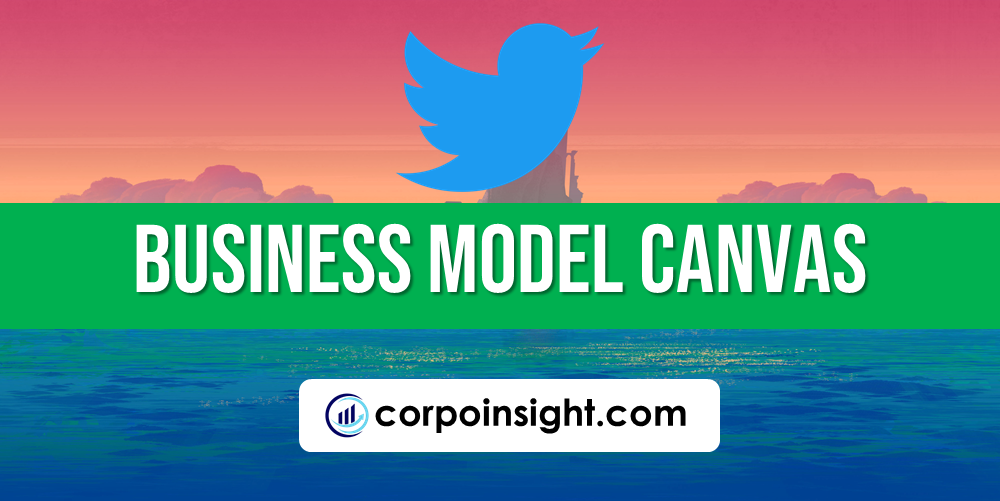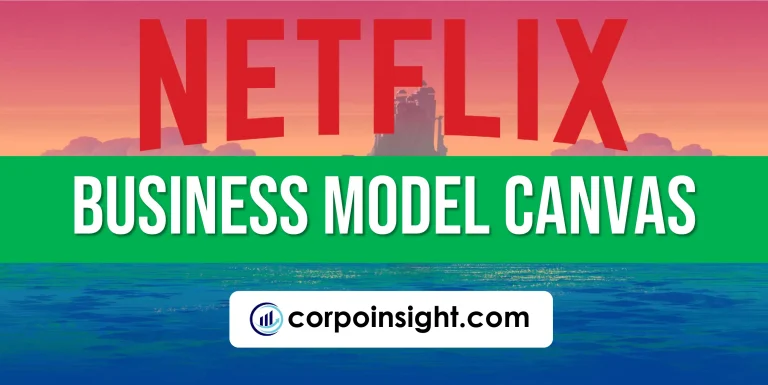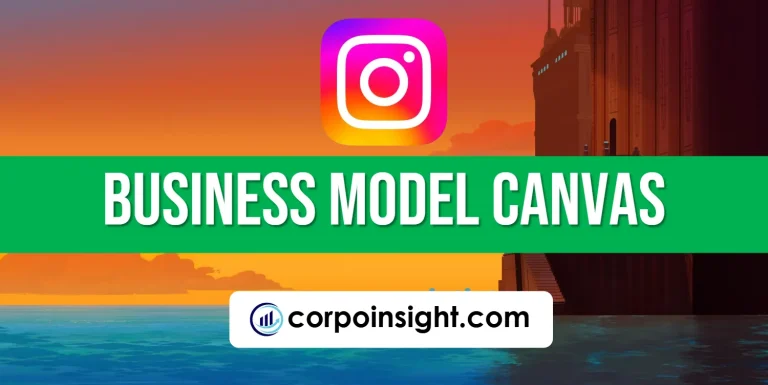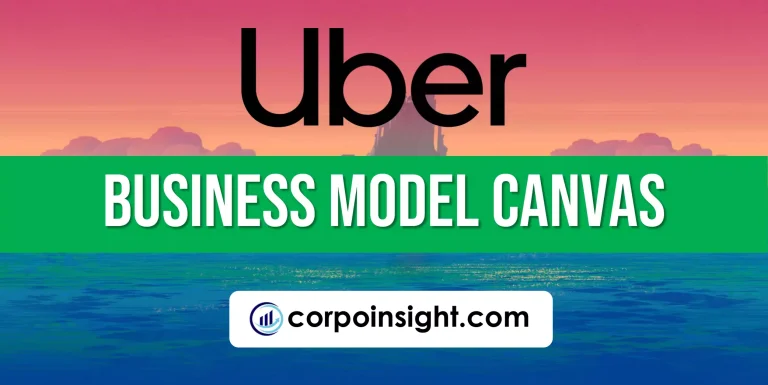Twitter Business Model Canvas 2024
Transcending the boundaries of traditional communication, Twitter’s real-time, dynamic platform has become an indispensable hub for global conversations, allowing users to seamlessly share ideas, insights, and experiences while shaping cultural narratives and fostering connections across diverse communities. In this Twitter Business Model Canvas, we will identify its customer segments, value proposition, revenue streams, channels, customer relationships, key activities, key resources, key partners, and cost structure.
Interesting fact!
The company once had a “Hire a Poet” program, where they hired poets to compose tweets for employees’ personal accounts.
Twitter Competitors
Facebook | Instagram | Snapchat | TikTok | LinkedIn | Reddit | Pinterest | Tumblr | Mastodon | Discord
Customer Segments – Twitter Business Model Canvas
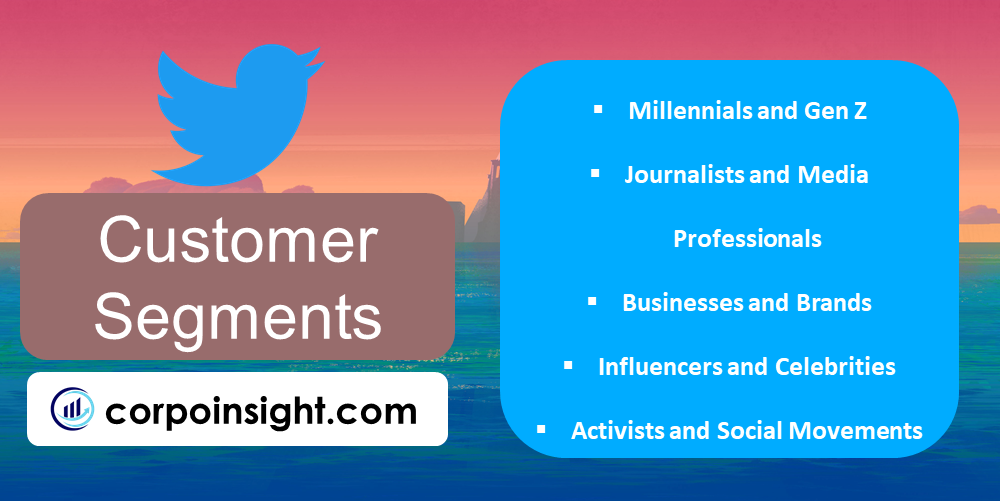
1. Millennials and Gen Z: Twitter’s vast user base comprises a significant portion of millennials and Gen Z individuals, who leverage the platform’s real-time nature to stay informed, express opinions, and engage with trending topics, thereby shaping the cultural discourse.
2. Journalists and Media Professionals: Renowned for its instantaneous dissemination of breaking news and events, Twitter has become an indispensable tool for journalists, media personalities, and content creators seeking to gather and share information swiftly.
3. Businesses and Brands: Recognizing Twitter’s unparalleled reach and influence, companies across various industries have embraced the platform as a powerful marketing channel, leveraging its ability to facilitate direct customer engagement and promote brand awareness.
4. Influencers and Celebrities: With its vast audience and real-time engagement, Twitter has emerged as a prime destination for influencers, celebrities, and public figures to connect with their fans, share updates, and leverage their influence to shape public opinion.
5. Activists and Social Movements: Twitter’s open and democratized nature has made it a potent platform for activists, advocacy groups, and social movements to mobilize support, raise awareness, and drive change through coordinated efforts and viral campaigns.
Value Proposition – Twitter Business Model Canvas
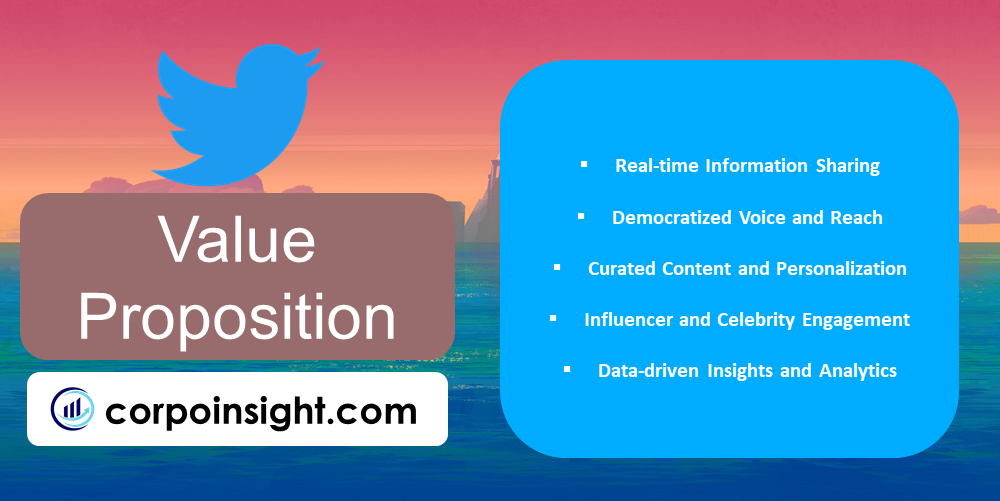
1. Real-time Information Sharing: Twitter’s ability to facilitate spreading information immediately and all at once, news, and updates has become its core value proposition, enabling users to stay informed and engaged with the latest happenings across various spheres.
2. Democratized Voice and Reach: By providing a democratized platform for expression, Twitter empowers individuals, businesses, and organizations to amplify their voices, share perspectives, and reach global audiences, transcending geographical and societal boundaries.
3. Curated Content and Personalization: Twitter allows users to curate their content streams through its advanced algorithms and customizable features, ensuring a personalized and tailored experience that aligns with their interests and preferences.
4. Influencer and Celebrity Engagement: Twitter’s vast network of influential personalities, celebrities, and thought leaders presents a unique opportunity for brands and individuals to connect, collaborate, and engage with these influential figures, driving visibility and credibility.
5. Data-driven Insights and Analytics: With its vast repository of user-generated data, Twitter offers businesses and organizations valuable insights into consumer trends, sentiment analysis, and market intelligence, enabling data-driven decision-making and strategic planning.
Revenue Streams – Twitter Business Model Canvas
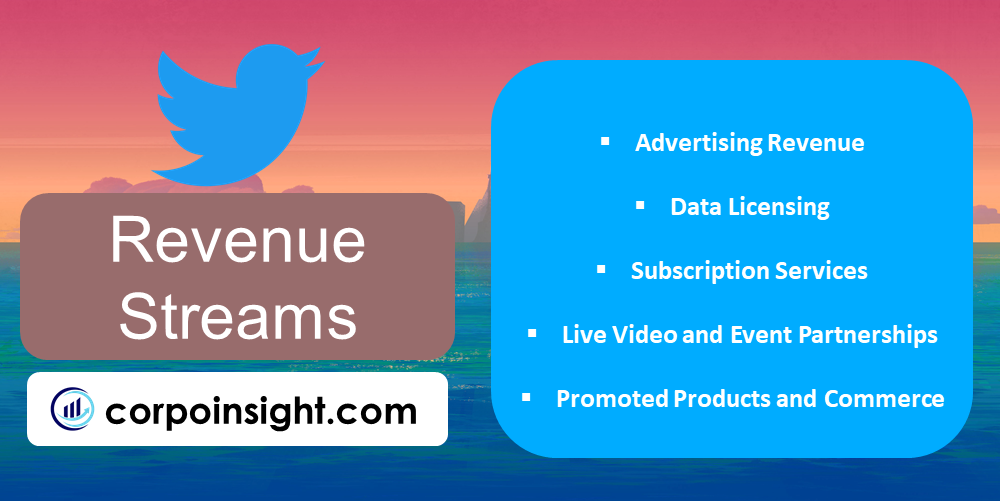
1. Advertising Revenue: Twitter’s primary revenue stream stems from its advertising offerings, which include promoted tweets, accounts, and trends, enabling businesses and brands to reach targeted audiences effectively through the platform’s vast user base.
2. Data Licensing: By leveraging its massive trove of user-generated data, Twitter generates revenue through data licensing agreements with third-party companies seeking valuable insights into consumer behavior, market trends, and sentiment analysis.
3. Subscription Services: With the introduction of Twitter Blue, a premium subscription service, the company has diversified its revenue streams, offering exclusive features, advanced analytics, and enhanced tools for power users and businesses.
4. Live Video and Event Partnerships: Twitter has capitalized on the growing demand for live video content by forging strategic partnerships with media companies, sports leagues, and entertainment entities, generating revenue through sponsorships and advertising during live-streamed events.
5. Promoted Products and Commerce: Twitter’s foray into e-commerce and product promotions, facilitated by its influential user base and targeted advertising capabilities, has unlocked additional revenue opportunities through affiliate marketing and sponsored product placements.
Channels – Twitter Business Model Canvas
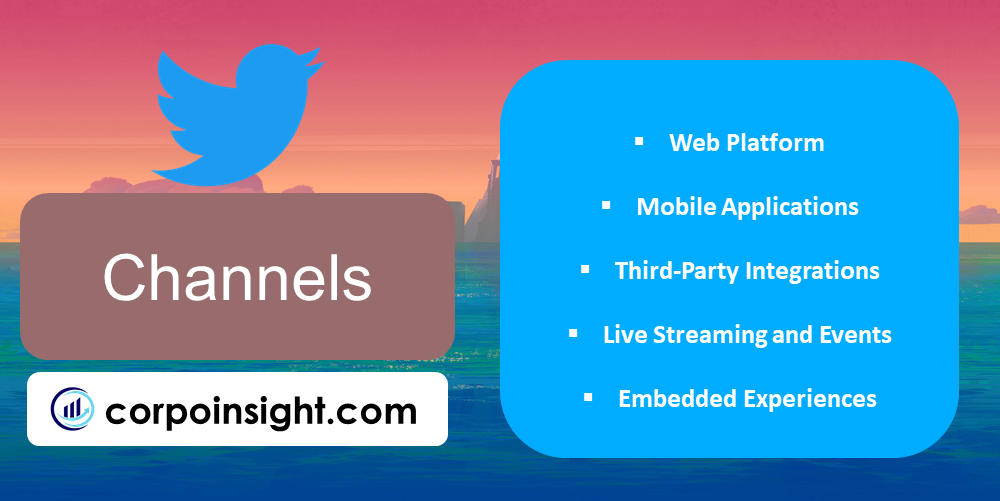
1. Web Platform: Twitter’s web-based platform remains a crucial channel, enabling users to access and engage with the service seamlessly through desktop and mobile browsers, facilitating real-time updates, content consumption, and interactions.
2. Mobile Applications: Recognizing the ubiquity of mobile devices, Twitter has developed robust mobile applications for iOS and Android, providing users with a streamlined and optimized experience for on-the-go access, engagement, and content creation.
3. Third-Party Integrations: Twitter has fostered strategic partnerships with third-party platforms and services, enabling users to share and consume content seamlessly across various applications, websites, and ecosystems, extending its reach and engagement opportunities.
4. Live Streaming and Events: Leveraging its real-time nature, Twitter has emerged as a prominent channel for live-streaming events, enabling users to participate in and witness breaking news, sports events, and cultural happenings as they unfold.
5. Embedded Experiences: Twitter has facilitated the integration of its content and features into external websites and applications through embedded timelines, widgets, and buttons, allowing businesses and publishers to incorporate Twitter experiences within their digital properties seamlessly.
Customer Relationships – Twitter Business Model Canvas
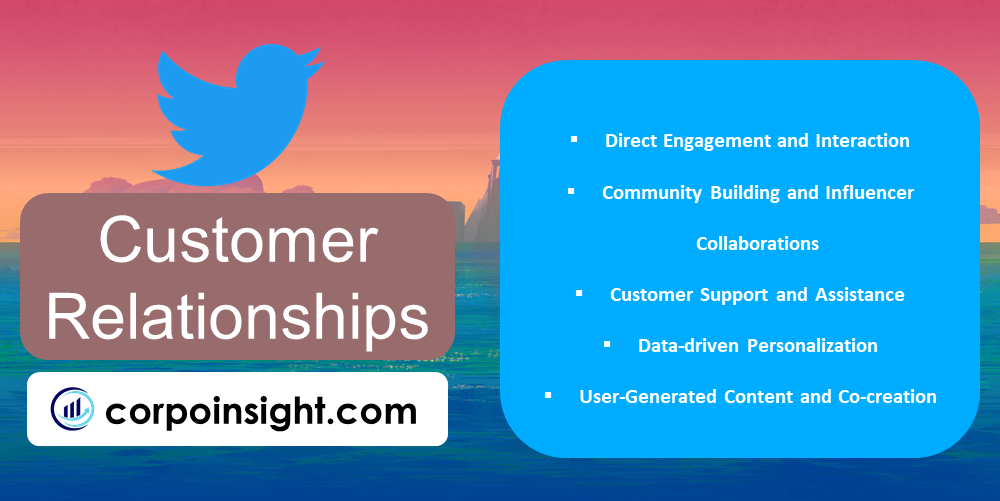
1. Direct Engagement and Interaction: Twitter’s platform fosters direct and real-time engagement between users, brands, and influencers, enabling two-way communication, feedback, and personalized responses, thereby cultivating strong customer relationships built on transparency and responsiveness.
2. Community Building and Influencer Collaborations: By facilitating the formation of interest-based communities and enabling influencer collaborations, Twitter empowers brands to establish lasting connections with their target audiences, fostering brand loyalty and advocacy through shared interests and experiences.
3. Customer Support and Assistance: Recognizing the importance of prompt and efficient customer support, Twitter has implemented dedicated channels and resources to address user inquiries, concerns, and issues, ensuring a positive and satisfactory user experience.
4. Data-driven Personalization: Leveraging its vast data resources, Twitter tailors user experiences through personalized content recommendations, targeted advertising, and customizable settings, delivering a highly relevant and engaging experience that strengthens customer relationships.
5. User-Generated Content and Co-creation: By encouraging and amplifying user-generated content, Twitter fosters a sense of co-creation and ownership among its user base, fostering a collaborative relationship where customers actively shape and contribute to the platform’s content ecosystem.
Key Activities – Twitter Business Model Canvas
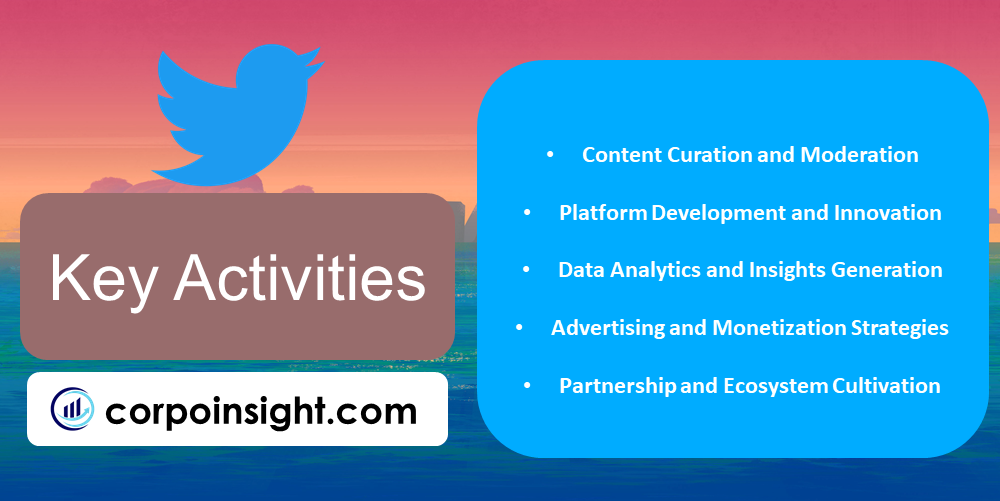
1. Content Curation and Moderation: Twitter’s ability to curate and moderate the vast volume of user-generated content in real-time is a critical activity, ensuring a safe, relevant, and engaging experience for its users while upholding community standards and guidelines.
2. Platform Development and Innovation: Continuously enhancing and evolving its platform is a key activity for Twitter, as it strives to introduce new features, improve user experiences, and stay ahead of emerging trends and technological advancements in the social media landscape.
3. Data Analytics and Insights Generation: With a wealth of user data, Twitter dedicates significant resources to data analytics and insights generation, allowing the company to derive valuable intelligence about user behaviour, preferences, and industry trends, which inform strategic decision-making.
4. Advertising and Monetization Strategies: Developing and implementing effective advertising and monetization strategies is crucial for Twitter, as it aims to maximize revenue streams while delivering targeted and relevant advertising experiences to its user base.
5. Partnership and Ecosystem Cultivation: Fostering strategic partnerships with businesses, content creators, and industry leaders is a key activity for Twitter, as it seeks to expand its ecosystem, enhance its offerings, and unlock new opportunities for growth and monetization.
Key Resources – Twitter Business Model Canvas
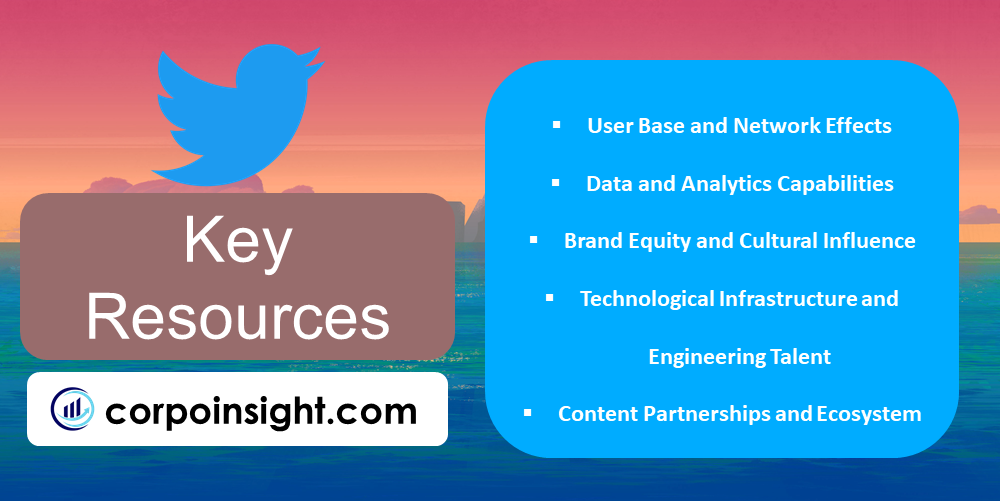
1. User Base and Network Effects: Twitter’s vast and highly engaged user base, spanning diverse demographics and interests, is an invaluable resource that fuels the platform’s network effects, driving continuous growth and sustained relevance in the social media landscape.
2. Data and Analytics Capabilities: The enormous volume of user-generated data and Twitter’s sophisticated data analytics capabilities represent a critical resource, enabling the platform to derive valuable insights, personalize experiences, and inform strategic decision-making processes.
3. Brand Equity and Cultural Influence: Twitter’s established brand equity and its status as a cultural juggernaut, shaping public discourse and amplifying voices, serve as a powerful resource, attracting users, advertisers, and strategic partners alike.
4. Technological Infrastructure and Engineering Talent: Twitter’s robust technological infrastructure, coupled with its highly skilled engineering and development teams, constitutes a vital resource, ensuring seamless platform operation, scalability, and the ability to innovate and introduce new features rapidly.
5. Content Partnerships and Ecosystem: Twitter’s extensive ecosystem of content partnerships with media outlets, influencers, and industry leaders represents a valuable resource, enabling the platform to curate diverse and engaging content while fostering strategic collaborations and revenue opportunities.
Key Partners – Twitter Business Model Canvas
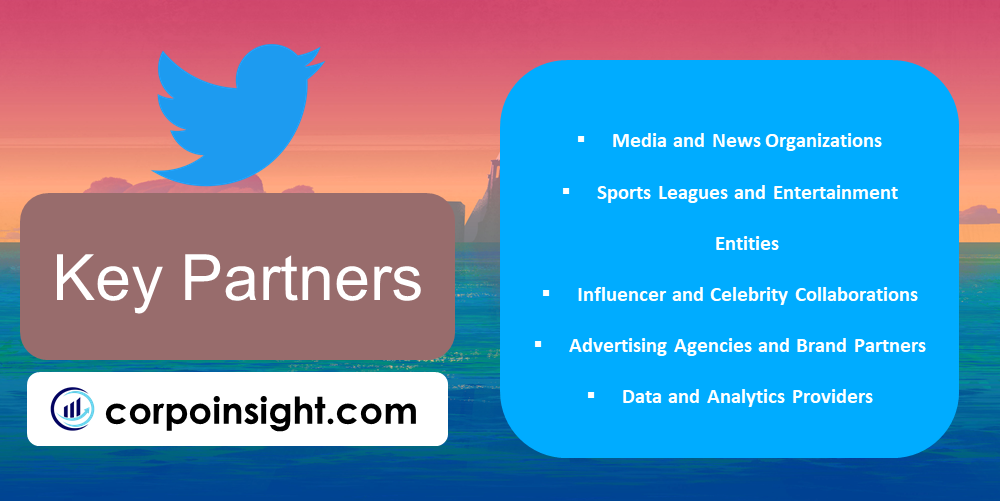
1. Media and News Organizations: Twitter has forged strategic partnerships with prominent media outlets and news organizations, enabling real-time reporting, content sharing, and amplification of breaking news stories, thereby positioning itself as a critical platform for news dissemination.
2. Sports Leagues and Entertainment Entities: By collaborating with major sports leagues, entertainment companies, and cultural events, Twitter has secured exclusive content partnerships, providing its users access to live-streamed events, behind-the-scenes content, and unique engagement opportunities.
3. Influencer and Celebrity Collaborations: Recognizing the power of influencers and celebrities in shaping public discourse, Twitter actively cultivates partnerships with influential personalities, enabling them to leverage the platform’s reach and engage with their fan bases more effectively.
4. Advertising Agencies and Brand Partners: Twitter’s partnerships with advertising agencies and prominent brands are crucial for driving its advertising revenue streams, as these collaborations facilitate targeted marketing campaigns, sponsored content, and innovative advertising solutions tailored to specific audiences.
5. Data and Analytics Providers: To enhance its analytics capabilities and derive deeper insights from user-generated data, Twitter has established partnerships with leading data and analytics providers, enabling the platform to offer more comprehensive and valuable data-driven solutions to businesses and advertisers.
Cost Structure – Twitter Business Model Canvas
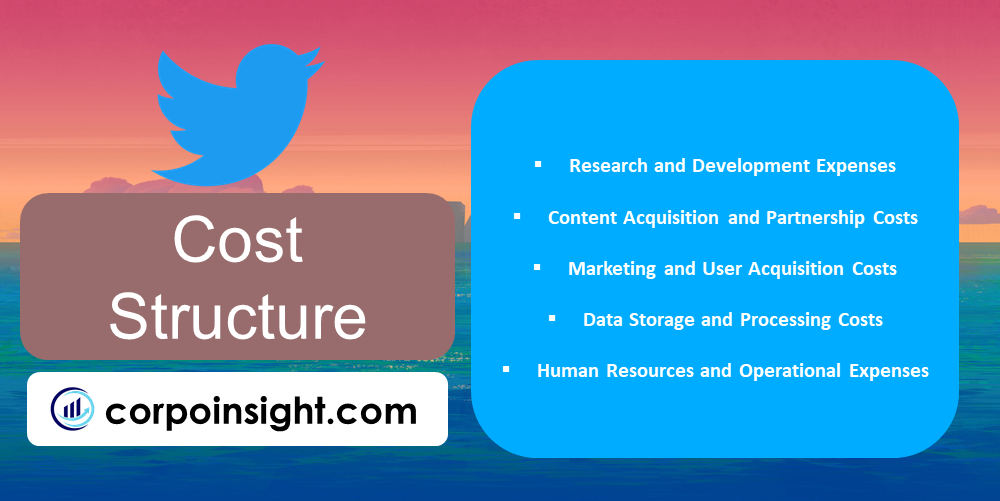
1. Research and Development Expenses: Twitter’s continuous pursuit of innovation and platform enhancement necessitates substantial investments in research and development activities, including engineering talent, infrastructure upgrades, and the exploration of emerging technologies, constituting a significant portion of its cost structure.
2. Content Acquisition and Partnership Costs: To maintain its position as a leading content distribution platform, Twitter incurs significant costs associated with acquiring exclusive rights and negotiating partnerships with media organizations, sports leagues, and entertainment entities, ensuring a steady stream of engaging and premium content.
3. Marketing and User Acquisition Costs: In the highly competitive social media landscape, Twitter dedicates substantial resources to marketing and user acquisition efforts, including advertising campaigns, influencer collaborations, and promotional activities aimed at attracting new users and retaining existing ones.
4. Data Storage and Processing Costs: With the massive volume of user-generated data flowing through the platform, Twitter faces substantial costs related to data storage, processing, and analysis, requiring robust infrastructure, advanced analytics tools, and scalable solutions to handle this ever-growing resource.
5. Human Resources and Operational Expenses: As a technology-driven company, Twitter’s cost structure encompasses significant human resources expenses, including salaries, benefits, and training for its highly skilled workforce, as well as operational costs associated with maintaining a global presence and supporting its diverse user base.
Summary of Twitter Business Model Canvas
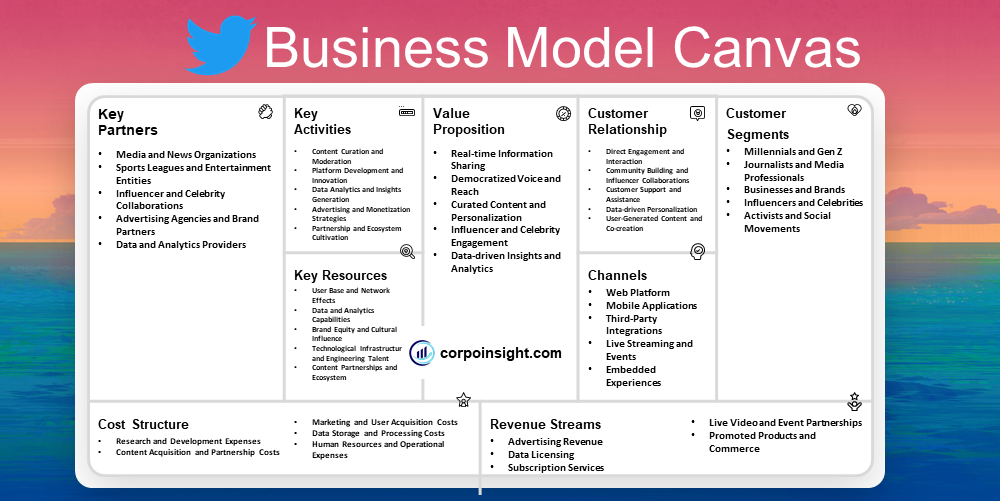
Conclusion on Twitter Business Model Canvas
Twitter’s business model canvas revolves around its real-time content-sharing platform, leveraging user-generated data, advertising revenue, and strategic partnerships. By fostering a vast network of users, brands, and influencers, Twitter creates value through personalized experiences, targeted advertising, and data-driven insights. Its robust technological infrastructure, talent pool, and brand equity position it as a cultural catalyst, shaping public discourse and driving revenue through innovative monetization strategies.

Majoring in marketing from Bangladesh University of Professionals, Sadman Abrar is a learner, obsessed with branding and intrigued to learn about different company strategies, and currently working at bKash.

